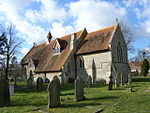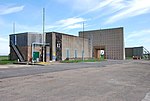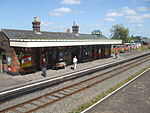Westcott railway station
Westcott railway station was a small station built to serve the village of Westcott, Buckinghamshire, and nearby buildings attached to Baron Ferdinand de Rothschild's estate at Waddesdon Manor. It was built by the Duke of Buckingham in 1871 as part of a short horse-drawn tramway to allow for the transport of goods from and around his extensive estates in Buckinghamshire and to connect the Duke's estates to the Aylesbury and Buckingham Railway at Quainton Road. A lobbying campaign by residents of the town of Brill led to the tramway being converted for passenger use and extended to Brill railway station in 1872, becoming known as the Brill Tramway. Cheaply built and ungraded, and using poor quality locomotives, services on the line were very slow, initially limited to 5 miles per hour (8 km/h). In the 1890s it was planned to extend the tramway to Oxford, but the scheme was abandoned. Instead, the operation of the line was taken over by the Metropolitan Railway in 1899. Following the 1933 transfer of the Metropolitan Railway to public ownership to become the Metropolitan line of London Transport, Westcott station became a part of the London Underground, despite being over 40 miles (64 km) from central London. The management of London Transport believed it very unlikely that the line could ever be made viable, and Westcott station was closed, along with the rest of the line, from 30 November 1935. The station building and its associated house are the only significant buildings from the Brill Tramway to survive other than the former junction station at Quainton Road.
Excerpt from the Wikipedia article Westcott railway station (License: CC BY-SA 3.0, Authors).Westcott railway station
Ashendon Road,
Geographical coordinates (GPS) Address Nearby Places Show on map
Geographical coordinates (GPS)
| Latitude | Longitude |
|---|---|
| N 51.845 ° | E -0.95555555555556 ° |
Address
Ashendon Road
HP18 0NX
England, United Kingdom
Open on Google Maps









